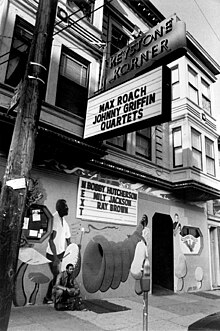Keystone Korner

Odean Pope in front of Keystone Korner, 1982
|
|
| Location | 750 Vallejo Street San Francisco, California United States |
|---|---|
| Coordinates | 37°47′55″N 122°24′34″W / 37.798586°N 122.409374°WCoordinates: 37°47′55″N 122°24′34″W / 37.798586°N 122.409374°W |
| Owner | Todd Barkan |
| Type | Nightclub |
| Genre(s) | Jazz |
| Capacity | 200 |
| Opened | 1972 |
| Closed | 1983 |
Keystone Korner was an important jazz music club in the North Beach neighborhood of San Francisco, which opened in 1972 and continued operation until 1983. Many live recordings were made at the club.Jessica Williams was the house pianist for a number of years.
In 1969, Freddie Herrera bought Dino and Carlo's Bar in the North Beach section of San Francisco. He changed the name to Keystone Korner, a reference to Keystone Cops, because of its proximity to the Central Police Station on the opposite corner of Emery Lane.
Keystone Korner began as a topless bar, but quickly changed direction when songwriter Nick Gravenites convinced Herrera that live music would bring in more customers. The strength of the music scene in San Francisco allowed Herrera to book young musicians who would go on to stellar careers. Patrons filled the club to hear new talents such as Elvin Bishop, Neal Schon, Boz Scaggs, and The Pointer Sisters. Herrera's success made it possible to move across the San Francisco Bay and open a larger room called Keystone Berkeley. He then sold the Keystone Korner to Todd Barkan who converted the nightclub from a popular rock venue to an internationally famous jazz club.
Barkan paid $12,500 (equivalent to $71,569 in 2016) for the Keystone Korner in 1972, and hired some of the biggest names in jazz to play in his new nightspot. Early gigs by men like Sonny Rollins and Art Blakey established the Keystone as one of the best jazz clubs in the nation—a reputation that continued to build as legends like Miles Davis, McCoy Tyner, Bill Evans, Betty Carter and Stan Getz appeared on its stage.
Over the course of eleven years, the Keystone Korner showcased many of the world's best musicians, whose live recordings have become important contributions to the jazz canon. However, economic challenges took their toll, and Barkan was forced to close the Keystone Korner in 1983.
...
Wikipedia
